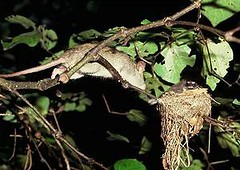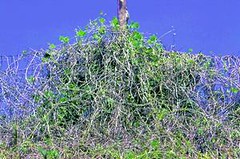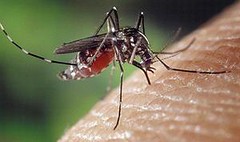 世貿組織(WTO)本月中在一項會議中達成共識,認為世貿組織在食物安全及動植物健康方面的規範,可用來控制外來種或入侵種跨越邊際、引入新棲地造成的環境災害。
世貿組織(WTO)本月中在一項會議中達成共識,認為世貿組織在食物安全及動植物健康方面的規範,可用來控制外來種或入侵種跨越邊際、引入新棲地造成的環境災害。
在一生態系中已達成平衡的物種,如果被引進另一個棲地中則可能成為入侵種。外來入侵種的例子不勝枚舉,僅舉幾例:快速成長的葛藤、橢圓懸鉤子、光肩星天牛、緬甸蟒、北太平洋海星、火樹、火蟻、瘋蟻、藍貽貝、斑馬貽貝、鼠、豬、山羊及鹿都名列其中。
外來種指得是那些被引入新的棲地、族群成長到威脅該地生物多樣性的物種,包括了農業作物及馴養的野生動物。外來種的威脅包括競爭食物資源、散佈疾病、散佈捕食者。
貿易是目前外來物種引入新棲地的主要途徑,包括了裝載貨物時意外夾帶的物種。
外來種也可透過直接交易物種本身引入:包括農場的作物或動物、馴養寵物、觀賞用植物或為控制有害動物所引入的捕食者。
引入外來入侵種 貿易是主要途徑
 舉例來說,緬甸蠎可以長到16英尺長,為全球最嚴重的外來種之一;由飼主棄置於佛羅里達濕地國家公園後數量遽增。目前估計約有3萬隻緬甸蠎棲息並捕獵當地瀕危的鳥類及短吻鱷。
舉例來說,緬甸蠎可以長到16英尺長,為全球最嚴重的外來種之一;由飼主棄置於佛羅里達濕地國家公園後數量遽增。目前估計約有3萬隻緬甸蠎棲息並捕獵當地瀕危的鳥類及短吻鱷。
白線斑蚊是另一種全球惡名昭彰的外來種,牠散佈包括登革熱、西尼羅病毒及日本腦炎在內的許多人類疾病。這些蚊子藉由國際輪胎貿易過程中,輪胎放於戶外時盛接的雨水散佈到世界各地。
美洲巨水鼠(coypu)是原產於南美洲半水棲的齧齒動物。由毛皮農場脫逃或放出導致現今在北美、歐洲及亞洲都有為數可觀的野外族群量。牠們穿鑿的洞穴對河堤、堤壩及灌溉設備產生危害。由於牠們的覓食方式破壞大範圍的蘆葦沼澤,因此造成植物、昆蟲、鳥類及魚類的棲地喪失。
各方貿易代表出席「國際貿易與外來入侵種」會議
 世貿組織制訂食品安全及動植物健康方面的貿易規範,是為了保護公眾健康與環境,但又要避免成員國以此作為貿易保護主義的藉口,來保護其國內生產者免於競爭。因此,由「食品安全檢驗與動植物防疫檢疫措施協定」(SPS協定)開始,均必須根據科學風險分析或是公認的國際標準,來制訂有害動植物的控制規範。
世貿組織制訂食品安全及動植物健康方面的貿易規範,是為了保護公眾健康與環境,但又要避免成員國以此作為貿易保護主義的藉口,來保護其國內生產者免於競爭。因此,由「食品安全檢驗與動植物防疫檢疫措施協定」(SPS協定)開始,均必須根據科學風險分析或是公認的國際標準,來制訂有害動植物的控制規範。
在7月12-13日召開的「國際貿易與外來入侵種」會議,標準及貿易發展促進會(Standards and Trade Development Facility)是主辦單位之一,該機構是一國際性合作機構,主要任務協助發展中國家協議食品安全及動植物健康的國際標準。
另外,《國際植物保護公約》(IPCC)秘書處及「世界動物衛生組織」(OIE)也是該會議的合辦單位,這兩個機構與另一機構,是SPS協定中所指定的3個標準制訂組織。
 在這次會議中,世界衛生組織與聯合國糧農組織代表,以及來自太平洋、加勒比海、北美和歐洲各組織的代表,與歐美、紐西蘭、肯亞、蘇丹、巴西的官方代表均出席與會,分別闡述他們在各國內的外來種問題處理現況。
在這次會議中,世界衛生組織與聯合國糧農組織代表,以及來自太平洋、加勒比海、北美和歐洲各組織的代表,與歐美、紐西蘭、肯亞、蘇丹、巴西的官方代表均出席與會,分別闡述他們在各國內的外來種問題處理現況。
也有企業代表在會中簡報他們可以貢獻的方案──儘管他們有時候被當作外來種擴散的元兇。
世界銀行2010的報告指出,氣候變遷亦助長了外來動植物的蔓延、導致危害森林、漁業及作物,造成環境及生計的雙重打擊。報告中說:「全球外來入侵種造成的損失估計每年至少有140萬兆美元,佔每年全球經濟的5%。」
與會者也討論到,透過網路交易的的郵寄包裹,是引入外來種的最新途徑之一。
與會代表一致同意,加強SPS協定是防禦外來入侵種風險的首要工作。
以下為幾項確認為控制外來入侵種的關鍵行動:
- 促進國際組織的共同努力、相互支持,並強化彼此的能力,以貫徹實施SPS協定和全球生物多樣性公約。
- 確保現有的國際標準確實履行,防止外來有害物種的蔓延;針對有需要的地方訂定新的標準。
- 加強發展中國家進行科學風險分析的能力。
- 加強國內、國家間及區域各部會和其他機構的協調。從法律執行、海關與貿易、農業、漁業、林業和環境保護各層面,各機構有不同的責任。
- 政府和業界之間加強合作。
- 提高公眾及政治意識。
- 瞭解持續增長的網路交易的潛在風險及如何解決這些問題。
世界自然保育聯盟(IUCN)入侵種專家小組(Invasive Species.Specialist Group,ISSG)已製作了一份網路資料庫,詳情參考「全球百大外來入侵種資料庫」。
World Trade Organization rules on food safety and animal and plant health can be used to control environmental damage caused by alien and invasive species crossing borders into new habitats, a WTO seminar agreed last week.
Species that are in balance in one ecosystem can become invasive if they are introduced into another habitat. There are many: fast-growing kudzu plants, Asian wild raspberry bushes, Asian longhorn beetles, Burmese pythons, northern Pacific seastars, fire trees, fire ants, crazy ants, blue mussels, zebra mussels, mice, rats, pigs, goats and deer, to name just a few.
Alien species are those that are introduced into new habitats; they are invasive if they thrive so much that they threaten biodiversity, which includes agricultural and domestic species as well as wildlife.
The threats include competition for food, the spread of disease or the spread of predators.
Trade is a major pathway by which alien species can be introduced into new habitats. That includes the unintended spread in shipments of goods.
Alien species can also be spread through direct trade in the species themselves as farm animals or crops, domestic pets or ornamental plants, or predators introduced to control pests.
Burmese pythons, for example, which can grow to 16 feet in length, are one of the world's worst invasive species. Released by pet owners into the wetlands of Florida's Everglades National Park, they proliferated. Now an estimated 30,000 Burmese pythons prey on endangered birds and alligators.
The Asian tiger mosquito is another of world's worst invasive species. Linked to the transmission of many human diseases, including dengue fever, West Nile virus and Japanese encephalitis, these mosquitos are spread through the international tire trade in the rainwater retained in the tires when they are stored outside.
The coypu is a large semi-aquatic rodent which originated from South America. Due to escapes and releases from fur farms there are now large feral populations in North America, Europe and Asia. Their burrows penetrate and damage river banks, dykes and irrigation facilities. Their feeding methods lead to the destruction of large areas of reed swamp. Habitat loss caused by coypus harms plant, insect, bird and fish species.
The WTO rules govern trade measures on food safety and animal and plant health to avoid their use as an excuse for protectionism that would shield producers from import competition, rather than protecting health or the environment.
Set out in the Sanitary and Phytosanitary Measures Agreement, the rules do this by requiring measures to control the spread of destructive animals and plants to be based on a scientific analysis of risk or on recognized international standards.
The seminar on International Trade and Invasive Alien Species July 12 and 13 was co-organized by the Standards and Trade Development Facility, a partnership of international organizations that helps developing countries deal with international standards on food safety and animal and plant health.
Two of the three standards-setting organizations recognized in the SPS Agreement served as co-organizers - the International Plant Protection Convention, IPCC, and World Organisation for Animal Health, OIE.
Delegates from the World Health Organization and the UN Food and Agriculture Organization and organizations in the Pacific, Caribbean, North America and Europe participated together with representatives of agencies in the United States, European Union, New Zealand, Kenya, Sudan, Brazil, South Africa, Indonesia and elsewhere.
Speakers and participants described how the problem is being tackled in their countries or regions.
Representatives of the private sector, sometimes seen as culprits in the spread of alien species, described how their industries can contribute to the solution.
Climate change is set to drive the spread of invasive plant and animal species, threatening forests, fisheries and crops, in a double blow to nature and livelihoods, according to a World Bank-funded report released in 2010. "The estimated damage from invasive species worldwide totals more than $1.4 trillion annually - 5 percent of the global economy," according to the report.
One of the newest pathways for intentional introductions is mail order shopping through the Internet.
Seminar participants agreed that strengthening capacity under the Sanitary and Phytosanitary Measures Agreement is the first line of defense in managing the risks linked to invasive alien species.
- Key actions were identified to better control invasive alien species:
- boosting efforts to improve the way the international organizations work together, support each other and strengthen each other's ability to implement the SPS Agreement and global biodiversity conventions
- ensuring existing international standards are implemented better, to prevent trade from spreading harmful alien species and developing new standards where needed
- strengthening developing countries' ability to undertake scientific risk analysis
- improving coordination among ministries and other agencies within countries, between countries and within regions. The agencies' concerned have diverse responsibilities, from law enforcement, customs and trade to agriculture, fisheries, forestry and environmental protection
- enhancing cooperation between governments and industry
- raising public and political awareness
- studying potential risks associated with the growth in Internet trade, and how to address them
Click here to see "One Hundred of the World's Worst Invasive Alien Species" from the Global Invasive Species Database managed by the Invasive Species Specialist Group of the International Union for the Cconservation of Nature's Species Survival Commission.




